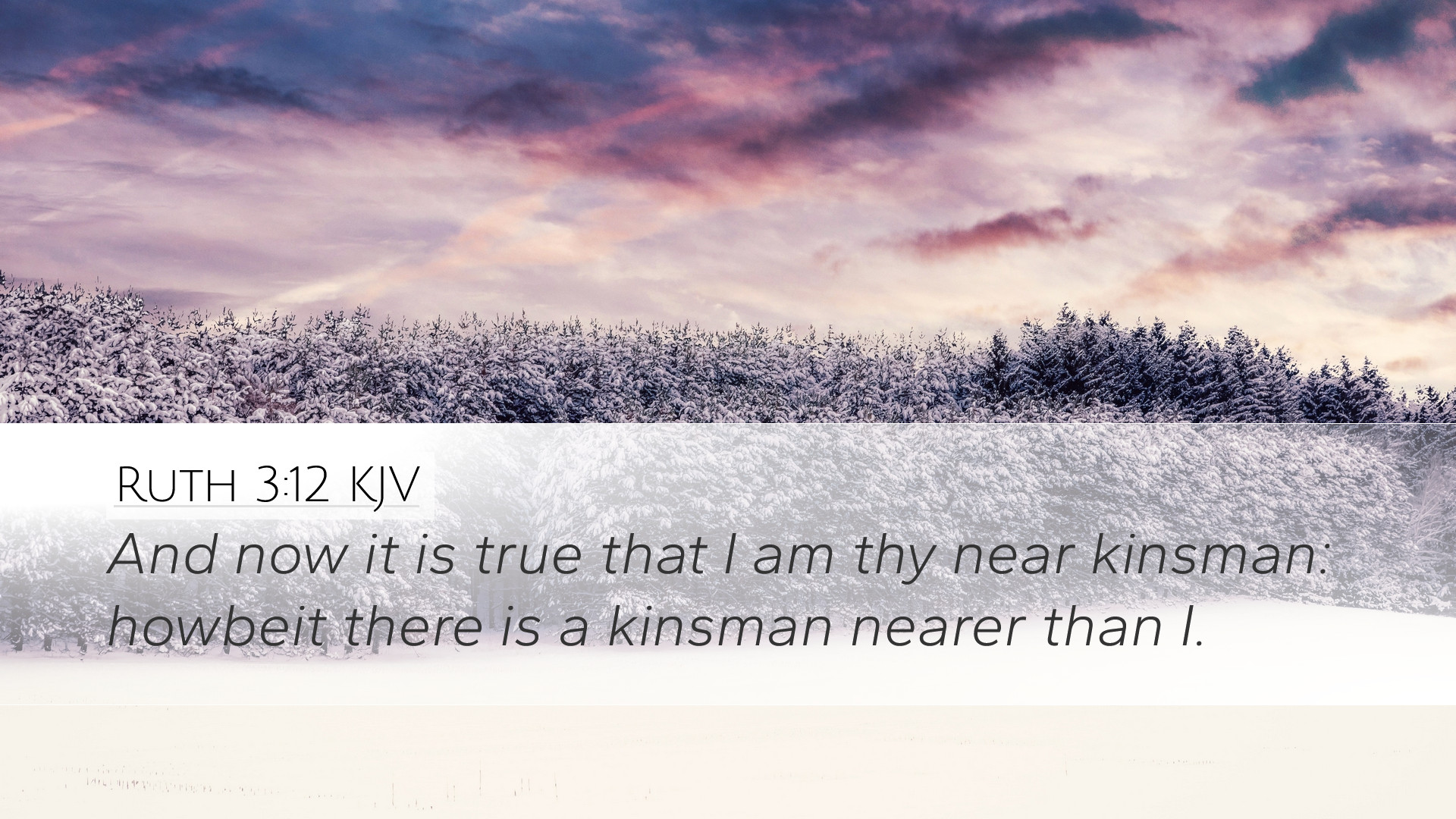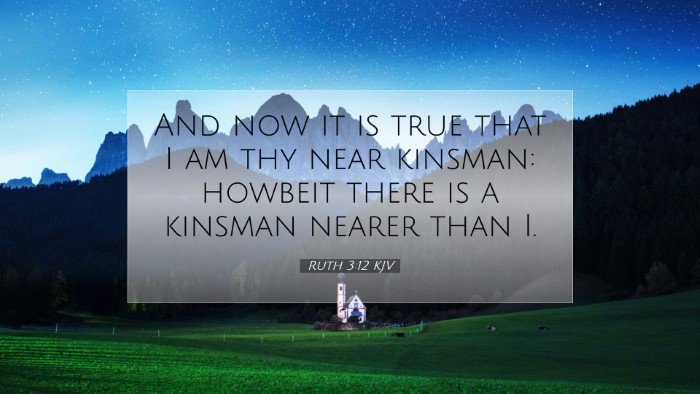Old Testament
Genesis Exodus Leviticus Numbers Deuteronomy Joshua Judges Ruth 1 Samuel 2 Samuel 1 Kings 2 Kings 1 Chronicles 2 Chronicles Ezra Nehemiah Esther Job Psalms Proverbs Ecclesiastes Song of Solomon Isaiah Jeremiah Lamentations Ezekiel Daniel Hosea Joel Amos Obadiah Jonah Micah Nahum Habakkuk Zephaniah Haggai Zechariah MalachiRuth 3:12
Ruth 3:12 KJV
And now it is true that I am thy near kinsman: howbeit there is a kinsman nearer than I.
Ruth 3:12 Bible Commentary
Bible Commentary on Ruth 3:12
Verse Context: Ruth 3:12 states, "And now it is true that I am a near kinsman: howbeit there is a kinsman nearer than I." This verse serves as a pivot in the narrative of Ruth, reflecting themes of redemption, obligation, and the legal structures surrounding kinship in ancient Israel.
Exegesis of Ruth 3:12
This passage arises during the pivotal moment when Ruth encounters Boaz at the threshing floor, an act filled with significant cultural and social implications. The acknowledgment by Boaz of his status as a "near kinsman" encapsulates the complexities of levirate marriage and the responsibilities that come with it.
Insights from Matthew Henry
Matthew Henry highlights the significance of Boaz's admission. He notes that it reflects not just an awareness of his role, but also an honor towards the law and the other kinsman. Henry argues that Boaz’s integrity is paramount; he wishes to adhere to the laws given to Israel about family and property redemption, demonstrating a model of righteous behavior.
Insights from Albert Barnes
Albert Barnes remarks that Boaz’s statement exhibits the importance of following proper procedures in matters of redemption. He elaborates on the historical and cultural context of kinsmanship, explaining that a 'near kinsman' was a critical figure in ensuring familial legacy is upheld. Barnes points out how Boaz willingly submits to the legal system, emphasizing his character and respect for social customs.
Insights from Adam Clarke
Adam Clarke provides a theological insight into Boaz's declaration, suggesting that it symbolizes the dual role of Christ as a Redeemer. Just as Boaz acknowledges a closer kinsman, Christ's relationship with humanity reflects a divine order where there are mediators and a structure of redemption at play. Clarke encourages readers to delve deeper into the implications of the Redeemer's choice and the fulfillment of God’s law through love and sacrifice.
Thematic Analysis
- Redemption: The nature of redemption and the responsibilities of a kinsman play a central role in the verses leading up to Ruth 3:12. Boaz’s recognition of his responsibility initiates a broader theme in the biblical narrative about the nature of redemption—both socially and spiritually.
- Legal and Cultural Obligations: The remark about a nearer kinsman is pivotal. It emphasizes that redemption comes with conditions, and that one must act according to the ethical and moral standards set forth in Scripture. This presents a profound study on the moral implications of law in relation to personal relationships.
- God’s Sovereignty: This passage subtly reveals the providential hand of God in the lineage of Christ. The recognition that there is a nearer kinsman leads to a critical juncture in God’s plan for redemption, reinforcing the narrative that God is orchestrating events in Ruth's life for His greater purpose.
Practical Insights for Application
This passage offers rich material for pastors and theologians on the nature of human and divine relationships. Here are several practical insights:
- Integrity in Relationships: Boaz’s adherence to his responsibilities serves as a model for integrity in our relationships. It calls believers to uphold truthfulness in their dealings with one another.
- Understanding God’s Law: The passage urges a deeper understanding of biblical law and its application in contemporary society. It is crucial for students and scholars to explore how ancient laws inform modern ethical practices.
- Foreshadowing Christ's Redemption: The dynamics between Boaz and Ruth foreshadow Christ’s sacrificial love and redemptive work. This symbolism is vital for theological reflection and preaching, making it an essential topic for teaching and discipleship.
Conclusion
Ruth 3:12 serves as a critical link in understanding the themes of redemption, law, and God’s sovereign plan throughout Scripture. By examining Boaz’s words and the context in which they were spoken, one may uncover layers of meaning that apply not only to the historical narrative but also to the contemporary believer’s life. The insights gathered from the chiseled wisdom of Matthew Henry, Albert Barnes, and Adam Clarke enrich our comprehension of this profound text.


